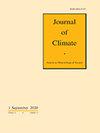两种不同大尺度天气模式下水汽和垂直运动对华北夏季暴雨形成的定量作用
IF 4
2区 地球科学
Q1 METEOROLOGY & ATMOSPHERIC SCIENCES
引用次数: 0
摘要
摘要 从1979-2019年期间用自组织地图算法分类的9种天气模式中,选取了华北地区夏季暴雨日(HRD)出现频率高于预期的两类不同的天气模式,分别称为类型1和类型2。华北上空的暴雨日各自表现出不同的特征,类型 1 呈北部分布,类型 2 呈南部分布。讨论了水汽含量和垂直运动方面的定量差异,以及与 HRD 相关的同步尺度模式。利用所谓的 "水量核算模式-2 "图层进行的 20 天逆向跟踪结果显示了水汽来源的显著对比。类型 1 主要接收来自北太平洋西部的水汽,而类型 2 则更依赖于来自阿拉伯海、孟加拉湾和欧亚大陆的水汽。然而,对网格单元贡献超过 0.01 毫米的主要水汽来源显示,类型 1 的累计贡献率为 77%,类型 2 为 80%。这一发现表明,两种类型之间的差异不能完全归因于水汽供应。对横向和切变Q矢量分量的进一步研究有助于深入了解这些不同的天气模式如何通过改变垂直运动来影响HRD。在类型 1 中,上层喷流入口诱发了热直接次级环流,从而增强了垂直运动,而在类型 2 中,条纹状槽在产生垂直运动方面发挥了主导作用。此外,每种天气模式的这些独特配置不仅预先存在,而且在 HRD 期间还会加强。本文章由计算机程序翻译,如有差异,请以英文原文为准。
The Quantitative Role of Moisture and Vertical Motion in Shaping Summer Heavy Rainfall over North China under Two Distinct Large-Scale Weather Patterns
Abstract Two distinct categories of weather patterns, denoted as Type 1 and Type 2, which show higher-than-expected frequency of summer heavy rainfall days (HRDs) over North China (NC), are selected from nine weather patterns categorized by the self-organizing map algorithm during 1979–2019. The respective HRDs over NC exhibit dissimilar characteristics, with Type 1 showing a northern distribution and Type 2 a southern distribution. The quantitative disparities in terms of moisture content and vertical motion are discussed in reactions to the synoptic-scale patterns associated with HRDs. The outcomes of a 20-day backward tracking, using the so-called Water Accounting Model-2layers, reveal noteworthy contrasts in moisture sources. Type 1 predominantly receives moisture from the western North Pacific, while Type 2 relies more on contributions from the Arabian Sea, Bay of Bengal, and Eurasia. However, the major moisture sources with grid cells contributing more than 0.01 mm show a consistent cumulative contribution of 77% for Type 1 and 80% for Type 2. The finding suggests that the discrepancy between the two types cannot be solely attributed to moisture supply. Further examination of the transverse and shearwise Q-vector components provides insights into how these distinct weather patterns influence HRDs by the alteration of vertical motion. In Type 1, an upper-level jet entrance induces a thermally direct secondary circulation that enhances vertical motion, while a baroclinic trough plays a dominant role in generating vertical motion in Type 2. Moreover, these unique configurations for each type of weather pattern are not only pre-existing but also intensified during HRDs.
求助全文
通过发布文献求助,成功后即可免费获取论文全文。
去求助
来源期刊

Journal of Climate
地学-气象与大气科学
CiteScore
9.30
自引率
14.30%
发文量
490
审稿时长
7.5 months
期刊介绍:
The Journal of Climate (JCLI) (ISSN: 0894-8755; eISSN: 1520-0442) publishes research that advances basic understanding of the dynamics and physics of the climate system on large spatial scales, including variability of the atmosphere, oceans, land surface, and cryosphere; past, present, and projected future changes in the climate system; and climate simulation and prediction.
 求助内容:
求助内容: 应助结果提醒方式:
应助结果提醒方式:


